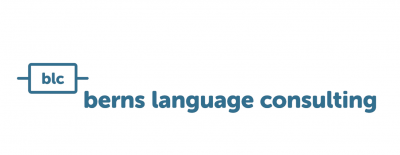A common question in the social context: What do you do professionally? Ah, language process consulting? Do you translate? No, you don’t do that? But what exactly are you consulting on? In some situations the language process consultant is inclined to answer the question about her profession right at the beginning of the conversation: Oh, I work in the office. But there is also the situation where she likes to catch up and explain:
What does blc actually do?
Our projects are as diverse as our customers. However, in the vast majority of cases it is about topics from the multilingual environment. Where many languages are bustling, there are also many challenges, that our customers face. As with complex translation processes, opaque language databases, new technologies in the market and constantly changing requirements? What areas might these be?
Areas of our expertise
Professional translation software
Let’s start with the translation itself. No, we translate ourselves, but we know what is important. Almost every company faces the challenge of promoting its offerings in multiple languages, i.e. providing all documentation and public presence in different languages. But how to tackle this issue?
Translations can cause a lot of work in a company, cost a lot of money, and can simply not be good enough in the end. Here we can support: We help our customers to get the right professional Translation software from a diverse market.
We take a close look at the initial situation and the specific requirements. We evaluate together with the customer, which tool to implement and with which processes can put translations on an efficient footing. And no! We do not translate ourselves! But we ensure the optimal process. You can find out more about this on our service pages or from Christiane Spooren.
Actually, a good translation starts long before the translation starts. In the creation of texts. Ideally, they are written in a way that they are understandable to the reader, uniform, precisely formulated and efficiently translatable. At blc, we develop rules and select appropriate tools that virtually look over the author’s shoulder and support the creation of texts. This ensures the quality of the text with regard to a subsequent translation already in the source language. We can also train the writers in the use of quality assurance tools, adapt them in a way that they help and do not restrict the authors.
Two blogs which are suitable for the topic:
A central topic in our work is …
Terminology management
A consistent corporate language is the linchpin for the creation of all documents, their consistent translation and thus a uniform appearance. At the heart of it is this stands Terminology management – creating and maintaining terminology is an exciting task that we are happy to support.
The creation of terminology should involve the right people from different areas, such as engineering or marketing, so that everyone can agree on a common language at an early stage. We help our customers set up terminology processes in such a way that the right contact persons are questioned and heard from the outset. Their very own conditions and needs are incorporated into a common process and are reflected in a (sometimes complex) termbase structure.
We also advise on the selection of the appropriate tool, so that the terminology data can be well stored, retrieved by the right group of people, is clearly maintained and can be further expanded. When it comes to day-to-day terminology work in the company, our terminologists can also actively support on an ongoing basis. They hold their protective hand over the processes and linguistic treasure of the company! Jenny Seidel explains not only what you are doing at blc, but also why it needs corporate terminology.
Machine translation
The fact that only translators can create texts in other languages using notes and pens is no longer a common practice today. The Machine translation ensures instantly available text in many language combinations. Everyone has already tried it and knows the surprisingly good, sometimes funny and sometimes almost incomprehensible results of machine translation.
So how can this technology be used in a company to reduce translation costs while also minimizing any risk of translation errors? Here we can help by providing the necessary knowledge to understand the thinking of machine translation. Our machine Translation Experts love to identify the right technology for the specific application.
And they also keep an eye on the entire process so that after machine translation – where and if necessary – the aforementioned pen-less translators can efficiently correct the texts with their linguistic knowledge. If you are wondering if machine translation is worthwhile in the company, I have of course also selected a blog for you, which you can find here.
Ideally, the output of the translation machine should already be so good that readers are neither confused nor, in the worst case, misdirected in their actions. To reach this level, technological muscle building is required. Yes, because these machines can be trained, which our experts take over, to turn the tool into a powerful support for users and translators.
Of course, they also ensure that this is adequately tested and evaluated. In addition to machine translation, the technology market offers more AI language tools. These small and clever helpers can help streamline the process, help eliminate author or translation errors, and even predict the quality of a text. Here, the blc experts always listen to the technology pulse and advise on the use of the possibilities.
Data is the basis of good technology! Where the data comes from and what Christian Eisold does with it he explains to you himself. For the translation haze circle, these are language data, i.e. texts. Lots of texts, lots of data. Regular care is required to keep them clean and to use them optimally.
Processing language data
Preparing language data first means cleaning up. Remove broken items, sort out unnecessary things and create neat structures. Thus, an orderly fund emerges from a disordered mass, ready for further use. An existing translation memory provides much better pre-translations when legacy items such as outdated terms, unclean translations, number turners and superfluous information are regularly removed or updated. This reduces costs, facilitates translation and helps to ensure text quality.
With a large amount of data, a machine translation machine can be trained to deliver really good and appropriate translations for a customer. The cleaner the data that goes into training, the better the machine translation can deliver. In addition, a large amount of text can be used to gain valuable terminology for the company. Our team of data specialists has a whole set of tools at hand for technical preparation, use their analytical thinking and turn a confusing database into a gold mine.
No, we do not translate. But we are there to ensure that the right processes are able to translate the way our customers need it.
What else does blc do?
Well, I’ll save that for more blogs. Because here at blc we still have some funny namings and not always easy to understand topics. That is why I will always talk to our experts and explain topics for you. Our LinkedIn profile tells you when the next blog will be available. (Don’t forget to follow us 😉 )
Next week you will learn what you do as a computer linguist at blc.








